不定式与v-ing分词用法区别
- 格式:doc
- 大小:41.00 KB
- 文档页数:13

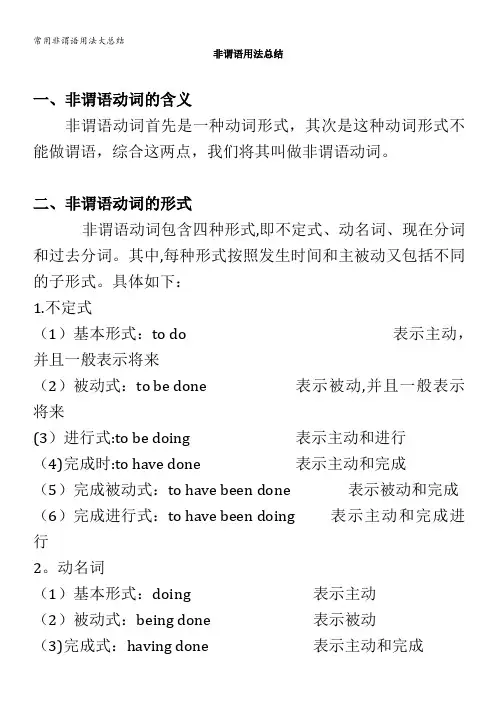
非谓语用法总结一、非谓语动词的含义非谓语动词首先是一种动词形式,其次是这种动词形式不能做谓语,综合这两点,我们将其叫做非谓语动词。
二、非谓语动词的形式非谓语动词包含四种形式,即不定式、动名词、现在分词和过去分词。
其中,每种形式按照发生时间和主被动又包括不同的子形式。
具体如下:1.不定式(1)基本形式:to do 表示主动,并且一般表示将来(2)被动式:to be done 表示被动,并且一般表示将来(3)进行式:to be doing 表示主动和进行(4)完成时:to have done 表示主动和完成(5)完成被动式:to have been done 表示被动和完成(6)完成进行式:to have been doing 表示主动和完成进行2。
动名词(1)基本形式:doing 表示主动(2)被动式:being done 表示被动(3)完成式:having done 表示主动和完成(4)完成被动式:having been done 表示被动和完成3.现在分词(1)基本形式:doing 表示主动和进行(2)被动式:being done 表示被动和进行(3)完成式:having done 表示主动和完成(4)完成被动式:having been done 表示被动和完成4.过去分词(1)done,及物动词的过去分词表示被动或完成;(2)不及物动词的过去分词表示主动或完成三、专题要点非谓语动词和独立主格结构主要用法如下:1。
动名词和动词不定式作主语、宾语;2。
只跟动名词作宾语的动词或动词短语;3.只跟动词不定式作宾语的常见动词;4.既可以跟动名词又可以跟动词不定式作宾语,且意义不同的动词或短语;5。
不定式、现在分词、过去分词作宾语补足语的区别;6。
不定式、现在分词、过去分词作定语时的区别;7。
不定式、现在分词、过去分词作状语时的区别;8。
动名词的复合结构在句中作状语;9.there be 结构的两种非谓语形式;10.独立主格结构在句中作状语;11。
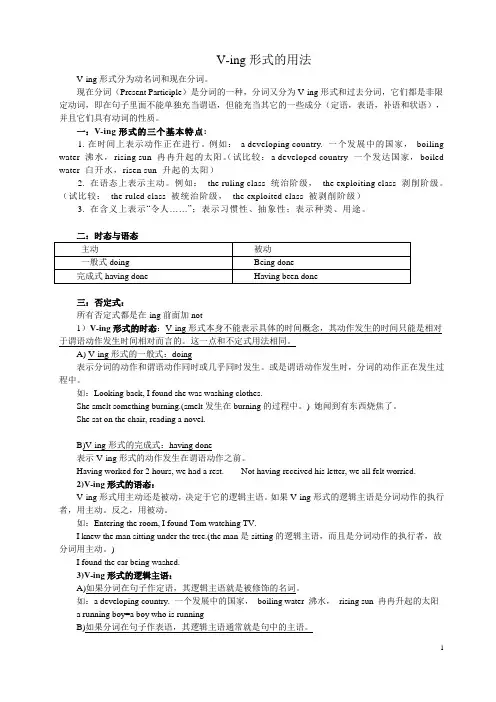
V-ing形式的用法V-ing形式分为动名词和现在分词。
现在分词(Present Participle)是分词的一种,分词又分为V-ing形式和过去分词,它们都是非限定动词,即在句子里面不能单独充当谓语,但能充当其它的一些成分(定语,表语,补语和状语),并且它们具有动词的性质。
一:V-ing形式的三个基本特点:1.在时间上表示动作正在进行。
例如:a developing country. 一个发展中的国家,boiling water 沸水,rising sun 冉冉升起的太阳。
(试比较:a developed country 一个发达国家,boiled water 白开水,risen sun 升起的太阳)2. 在语态上表示主动。
例如:the ruling class 统治阶级,the exploiting class 剥削阶级。
(试比较:the ruled class 被统治阶级,the exploited class 被剥削阶级)3. 在含义上表示“令人……”;表示习惯性、抽象性;表示种类、用途。
二:时态与语态主动被动一般式doing Being done完成式having done Having been done三:否定式:所有否定式都是在-ing前面加not1)V-ing形式的时态:V-ing形式本身不能表示具体的时间概念,其动作发生的时间只能是相对于谓语动作发生时间相对而言的。
这一点和不定式用法相同。
A)V-ing形式的一般式:doing表示分词的动作和谓语动作同时或几乎同时发生。
或是谓语动作发生时,分词的动作正在发生过程中。
如:Looking back, I found she was washing clothes.She smelt something burning.(smelt发生在burning的过程中。
) 她闻到有东西烧焦了。
She sat on the chair, reading a novel.B)V-ing形式的完成式:having done表示V-ing形式的动作发生在谓语动作之前。
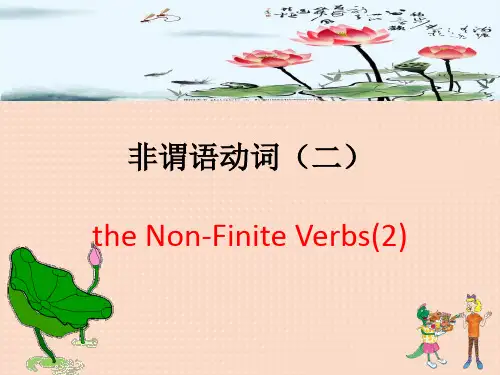

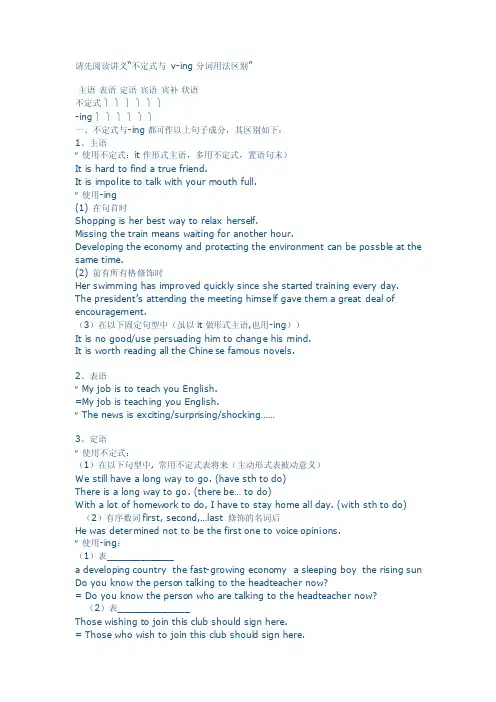
请先阅读讲义“不定式与v-ing分词用法区别”主语表语定语宾语宾补状语不定式⎫⎫⎫⎫⎫⎫-ing ⎫⎫⎫⎫⎫⎫一、不定式与-ing都可作以上句子成分,其区别如下:1、主语"使用不定式:it作形式主语,多用不定式,置语句末)It is hard to find a true friend.It is impoli te to talk with your mouthfull."使用-ing(1) 在句首时Shoppi ng is her best way to relaxhersel f.Missin g the trainmeanswaitin g for anothe r hour.Develo pingthe econom y and protec tingthe enviro nment can be possib le at the same time.(2) 前有所有格修饰时Her swimmi ng has improv ed quickl y sinceshe starte d traini ng everyday.The presid ent’s attend ing the meetin g himsel f gave them a greatdeal of encour ageme nt.(3)在以下固定句型中(虽以it做形式主语,也用-ing))It is no good/use persua dinghim to change his mind.It is worthreadin g all the Chines e famous novels.2、表语" My job is to teachyou Englis h.=My job is teachi ng you Englis h." The news is exciti ng/surpri sing/shocki ng……3、定语"使用不定式:(1)在以下句型中, 常用不定式表将来(主动形式表被动意义)We stillhave a long way to go. (have sth to do)Thereis a long way to go. (therebe… to do)With a lot of homewo rk to do, I have to stay home all day. (with sth to do) (2)有序数词fi rst, second,…last 修饰的名词后He was determ inednot to be the firstone to voiceopinio ns."使用-ing:(1)表____________a develo pingcountr y the fast-growin g econom y a sleepi ng boy the rising sun Do you know the person talkin g to the headte acher now?= Do you know the person who are talkin g to the headte acher now?(2)表_____________Thosewishin g to join this club should sign here.= Thosewho wish to join this club should sign here.Everyo ne attend ing the meetin g agreed to the plan.= Everyo ne who attend ed the meetin g agreed to the plan.(3)表_____________an intere sting story exciti ng news puzzli ng lights confus ingrules disapp ointi ng result s(4)表_____________a swimmi ng pool a walkin g stick a writin g desk a smokin g area a changi ng room4、宾语"使用不定式:在某些动词后He wishes to sleepat leastfor 8 hourseveryday.My father promis ed to buy me a cellph one if I got straig ht A in SAT.He preten ded to be asleep when I approa chedher.后接不定式作宾语的动词还有:______________________________________________________________ ______________________________________________________________ __________________________________"使用-ing(1)在某些动词后He is consid ering changi ng for a new job.后接-ing作宾语的动词还有:______________________________________________________________ ______________________________________________________________ __________________________________(2)在介词后She relaxe s hersel f by shoppi ng。
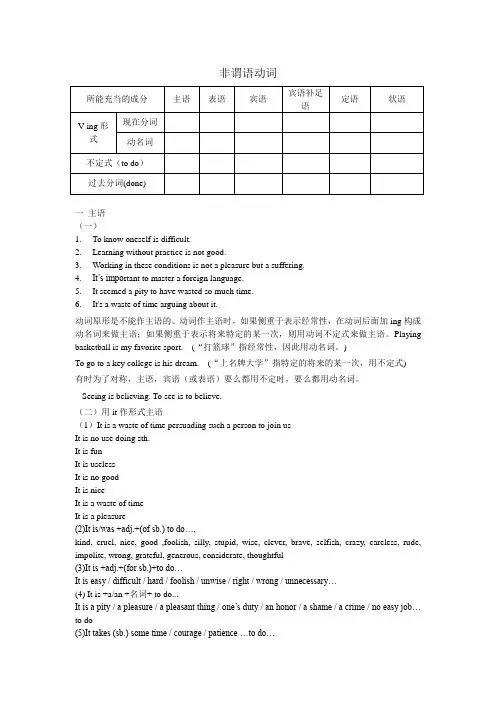
非谓语动词一主语(一)1.To know oneself is difficult.2.Learning without practice is not good.3.Working in these conditions is not a pleasure but a suffering.4.It’s impo rtant to master a foreign language.5.It seemed a pity to have wasted so much time.6.It's a waste of time arguing about it.动词原形是不能作主语的。
动词作主语时,如果侧重于表示经常性,在动词后面加ing构成动名词来做主语;如果侧重于表示将来特定的某一次,则用动词不定式来做主语。
Playing basketball is my favorite sport. (“打篮球”指经常性,因此用动名词。
)To go to a key college is his dream. (“上名牌大学”指特定的将来的某一次,用不定式)有时为了对称,主语,宾语(或表语)要么都用不定时,要么都用动名词。
Seeing is believing. To see is to believe.(二)用it作形式主语(1)It is a waste of time persuading such a person to join usIt is no use doing sth.It is funIt is uselessIt is no goodIt is niceIt is a waste of timeIt is a pleasure(2)It is/was +adj.+(of sb.) to do…,kind, cruel, nice, good ,foolish, silly, stupid, wise, clever, brave, selfish, crazy, careless, rude, impolite, wrong, grateful, generous, considerate, thoughtful(3)It is +adj.+(for sb.)+to do…It is easy / difficult / hard / foolish / unwise / right / wrong / unnecessary…(4) It is +a/an +名词+ to do...It is a pity / a pleasure / a pleasant thing / one’s duty / an honor / a shame / a crime / no easy job… to do(5)It takes (sb.) some time / courage / patience …to do…(6)It requires courage / patience / hard work… to do…___ is a good form of exercise for both young and old.A. The walkB. WalkingC. To walkD. Walk1._______ to sunlight for too much time will do harm to one’s skin.A. ExposedB. having exposedC. Being exposedD. After being exposed2.To answer correctly is more important than _____.A. that you finish quicklyB. finishing quicklyC. to finish quicklyD. finish quickly3.__________ now seems impossible.A. Saving moneyB. To save moneyC. Being saved moneyD. To be saved money4.He told us whether _________ a picnic was still under discussionA. to haveB. havingC. haveD. had6.What do you think made Mary so upset?_______ her new bicycle.A. As she lostB. LostC. LosingD. Because of losing7.It’s a waste of time ____________ this.A. discussB. discussingC. to discussedD. discussed(二) 宾语They didn't mind being treated like guests.He prefers to be starved to death rather than beg.1. They suggested _____ the sports meet till next Tuesday.A. us to put offB. putting offC. us of putting offD. our put off2. They managed _____the meeting room before the guests arrived.A. finishing to cleanB. finishing cleaningC. to finish cleaningD. to finish to clean(1)afford, ask, agree, arrange, attempt, care, choose, demand, decide, desire ,expect, fail, help, hope, hesitate, learn, long, manage, offer, plan, prepare, pretend, promise, refuse, want, wish (2)advise, suggest, allow, permit, avoid, consider, enjoy, finish, cannot help, imagine, include, keep, keep on, mind, miss, delay, practice, resist, postpone(推迟),delay, deny(否认), appreciate (欣赏,感激), escape, excuse, pardon, can’t stand, put off, give up, can’t help,(3)think of/about, dream of/about, hear of, prevent/keep/stop…from…, depend on, set about, succeed (in), worry about, burst out, insist on, be/get used to, devote…to…, lo ok forward to, pay attention to, get down to, be good at, do well in, be fond of, be interested in,1.She enjoys __________ light music.A. to hearB. hearingC. listening toD. to listen to2.We asked ___ to work in the countryside.A. to be sentB. to sendC. to be sendingD. sending3.There were many talented actors out there just waiting .A. to discoverB. to be discoveredC. discoveredD. being discovered4.You can keep the book until you __________.A. have finished readingB. finish to readC. will finish readingD. have finished to read5.Can you imagine yourself __________ on a desert island?A. stayingB. stayC. have stayedD. being stayed6.Almost everyone fails __________ on the first try.A. in passing his driver’s testB. to pass his driver’s testC. to have passed his driver’s testD. passing his driver’s test7.When he got off the train, it happened __________.A. to rainB. to be rainingC. rainingD. to raining8.The young driver offered _________ the patient out of the car.A. to handB. handingC. handsD. would hand9.Ali said that she wouldn’t mind _________ alone at home.A. leftB. being leftC. to be leftD. leaving(4)有些动词后即可用动名词也可以不定式做宾语(如like, love, hate, dislike, begin, start, continue, want, need, stop, remember, forget, try, attempt等)。
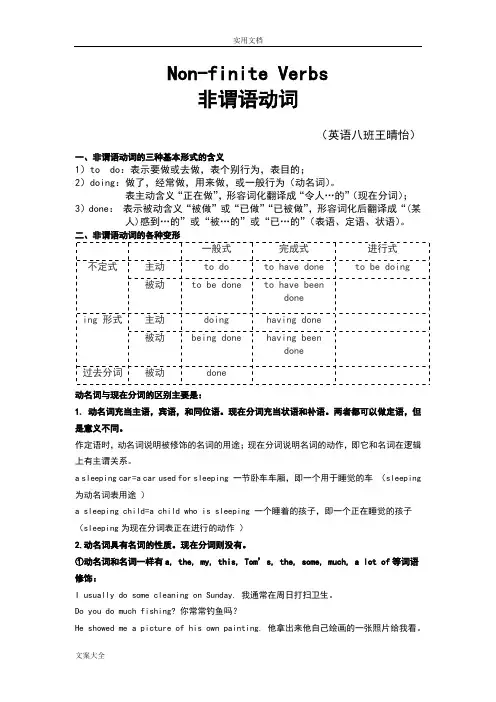
实用文档Non-finite Verbs 非谓语动词(英语八班王晴怡)一、非谓语动词的三种基本形式的含义1)to do:表示要做或去做,表个别行为,表目的;2)doing:做了,经常做,用来做,或一般行为(动名词)。
表主动含义“正在做”,形容词化翻译成“令人…的”(现在分词);3)done: 表示被动含义“被做”或“已做”“已被做”,形容词化后翻译成“(某人)感到…的”或“被…的”或“已…的”(表语、定语、状语)。
二、非谓语动词的各种变形一般式完成式进行式不定式主动to doto have doneto be doing被动to be doneto have been doneing 形式主动 被动doing being donehaving donehaving been done过去分词 被动done动名词与现在分词的区别主要是: 1. 动名词充当主语,宾语,和同位语。
现在分词充当状语和补语。
两者都可以做定语,但 是意义不同。
作定语时,动名词说明被修饰的名词的用途;现在分词说明名词的动作,即它和名词在逻辑 上有主谓关系。
a sleeping car=a car used for sleeping 一节卧车车厢,即一个用于睡觉的车 (sleeping 为动名词表用途 ) a sleeping child=a child who is sleeping 一个睡着的孩子,即一个正在睡觉的孩子 (sleeping 为现在分词表正在进行的动作 ) 2.动名词具有名词的性质。
现在分词则没有。
①动名词和名词一样有 a, the, my, this, Tom’s, the, some, much, a lot of 等词语 修饰: I usually do some cleaning on Sunday. 我通常在周日打扫卫生。
Do you do much fishing? 你常常钓鱼吗? He showed me a picture of his own painting. 他拿出来他自己绘画的一张照片给我看。
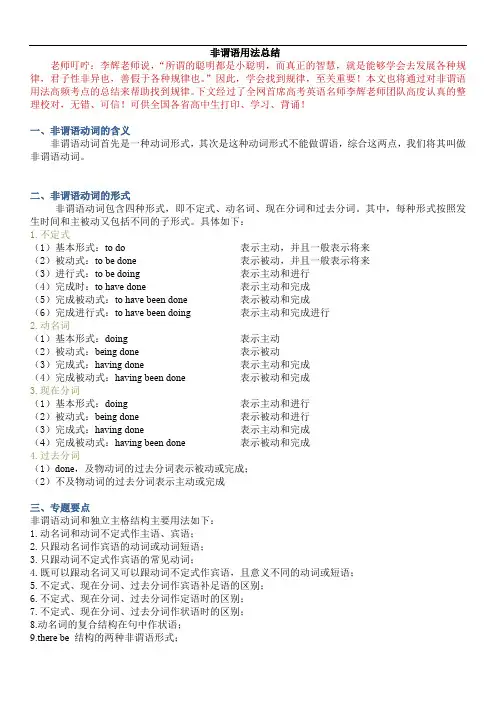
非谓语用法总结老师叮咛:李辉老师说,“所谓的聪明都是小聪明,而真正的智慧,就是能够学会去发展各种规律,君子性非异也,善假于各种规律也。
”因此,学会找到规律,至关重要!本文也将通过对非谓语用法高频考点的总结来帮助找到规律。
下文经过了全网首席高考英语名师李辉老师团队高度认真的整理校对,无错、可信!可供全国各省高中生打印、学习、背诵!一、非谓语动词的含义非谓语动词首先是一种动词形式,其次是这种动词形式不能做谓语,综合这两点,我们将其叫做非谓语动词。
二、非谓语动词的形式非谓语动词包含四种形式,即不定式、动名词、现在分词和过去分词。
其中,每种形式按照发生时间和主被动又包括不同的子形式。
具体如下:1.不定式(1)基本形式:to do表示主动,并且一般表示将来(2)被动式:to be done表示被动,并且一般表示将来(3)进行式:to be doing表示主动和进行(4)完成时:to have done表示主动和完成(5)完成被动式:to have been done表示被动和完成(6)完成进行式:to have been doing表示主动和完成进行2.动名词(1)基本形式:doing表示主动(2)被动式:being done表示被动(3)完成式:having done表示主动和完成(4)完成被动式:having been done表示被动和完成3.现在分词(1)基本形式:doing表示主动和进行(2)被动式:being done表示被动和进行(3)完成式:having done表示主动和完成(4)完成被动式:having been done表示被动和完成4.过去分词(1)done,及物动词的过去分词表示被动或完成;(2)不及物动词的过去分词表示主动或完成三、专题要点非谓语动词和独立主格结构主要用法如下:1.动名词和动词不定式作主语、宾语;2.只跟动名词作宾语的动词或动词短语;3.只跟动词不定式作宾语的常见动词;4.既可以跟动名词又可以跟动词不定式作宾语,且意义不同的动词或短语;5.不定式、现在分词、过去分词作宾语补足语的区别;6.不定式、现在分词、过去分词作定语时的区别;7.不定式、现在分词、过去分词作状语时的区别;8.动名词的复合结构在句中作状语;9.there be 结构的两种非谓语形式;10.独立主格结构在句中作状语;11.with复合结构在句中作状语或定语。
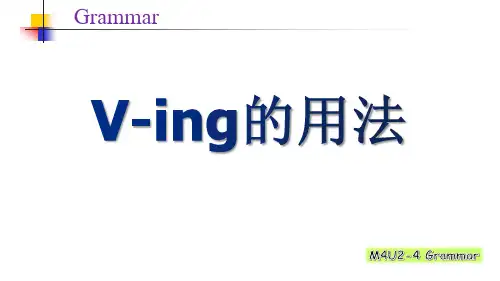
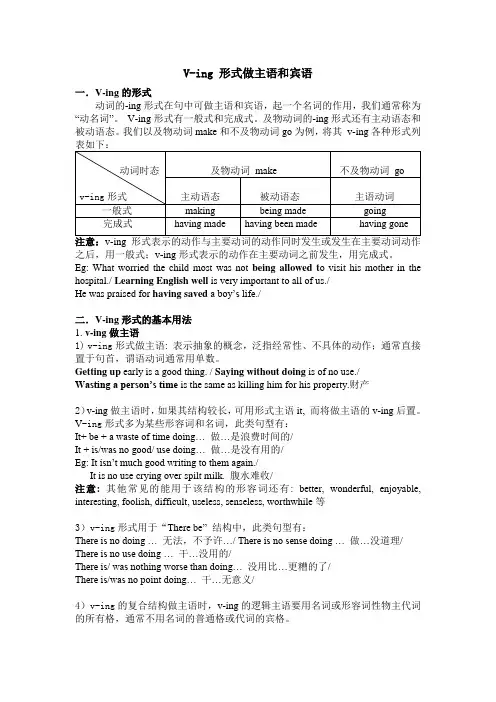
V-ing 形式做主语和宾语一.V-ing的形式动词的-ing形式在句中可做主语和宾语,起一个名词的作用,我们通常称为“动名词”。
V-ing形式有一般式和完成式。
及物动词的-ing形式还有主动语态和被动语态。
我们以及物动词make和不及物动词go为例,将其v-ing各种形式列之后,用一般式;v-ing形式表示的动作在主要动词之前发生,用完成式。
Eg: What worried the child most was not being allowed t o visit his mother in the hospital./ Learning English well is very important to all of us./He was praised for having saved a boy’s life./二.V-ing形式的基本用法1. v-ing做主语1) v-ing形式做主语: 表示抽象的概念,泛指经常性、不具体的动作;通常直接置于句首,谓语动词通常用单数。
Getting up early is a good thing. / Saying without doing is of no use./Wasting a person’s time is the same as killing him for his property.财产2)v-ing做主语时,如果其结构较长,可用形式主语it, 而将做主语的v-ing后置。
V-ing形式多为某些形容词和名词,此类句型有:It+ be + a waste of time doing… 做…是浪费时间的/It + is/was no good/ use doing… 做…是没有用的/Eg: It isn’t much good writing to them again./It is no use crying over spilt milk. 腹水难收/注意: 其他常见的能用于该结构的形容词还有: better, wonderful, enjoyable, interesting, foolish, difficult, useless, senseless, worthwhile等3)v-ing形式用于“There be”结构中,此类句型有:There is no doing … 无法,不予许…/ There is no sense doing … 做…没道理/ There is no use doing … 干…没用的/There is/ was nothing worse than doing… 没用比…更糟的了/There is/was no point doing… 干…无意义/4)v-ing的复合结构做主语时,v-ing的逻辑主语要用名词或形容词性物主代词的所有格,通常不用名词的普通格或代词的宾格。
Unit 9非谓语动词总结非谓语动词是高考的重点和热点,也是我们英语学习中所碰到的难点之一。
非谓语动词分为三种形式:不定式,V-ing分词(又分为现在分词和动名词)和过去分词。
一.基础知识1。
非谓语动词的语法功能所能充当的成分主语表语宾语宾语(主语)补足语定语插入语(独立成分)V—ing形式现在分词●●●●动名词●●●●不定式(to do)●●●●●●过去分词(done) ●●●●to tell you the truth(实话说),needless to say(不用说),to be honest/frank(老实说,坦白说),to bemore exact(更确切地说),to make things worse (更糟的是),not to mention…(更不用说),Generally / Frankly / Roughly speaking (一般说来/ 坦白说/ 粗略地说)2.非谓语动词的变化形式非谓语形式构成时态语态复合结构否定式主动被动不定式一般式to do to be donefor sb。
to dosth.或of sb. to do sth.在“to”前加not或never进行式to have doneto have beendone完成式to be doing /完成进行式to have been doing /动名词一般式doing being donesb。
或sb'sdoing作主语要用sb’s doing在前加not特别注意复合结构的否定式:sb’s not doingsb's not havingdone完成式having done having been done现在分词与动名词变化形式相同在前加not1。
非谓语作表语的重点①不定式、动名词与分词作表语的区别。
不定式和动名词作表语相当于一个名词作表语,含义是回答主语“是什么”;分词作表语相当于形容词作表语,含义是回答主语“怎么样”.Our plan is to keep the affair secret。
非谓语动词非谓语动词指不能单独作谓语,但同时仍保留动词某些特征的动词形式。
非谓语动词主要有不定式、V-ing形式、V-ed形式三类。
它们没有人称和数的变化,但是有的有时态和语态形式变化,还可以有自己的宾语、状语、逻辑主语等。
1、定义:在句中不充当谓语的动词称作非谓语动词。
2、形式:doing---动名词to do---不定式分词---现在分词doing 过去分词---done3、后跟doing型(偏执型)a) 动词+doing:例:enjoy, keep, be busy, finish, mind, can`t help, spend+时间+doing。
b) 介词+doing:例:after, before, feel like注意:“to”作为介词时后跟doing。
例:I go to school.“to”作为不定式时后跟do.例:I want to read the English books.常考短语:look forward to doing----期盼。
例:I look forward to receiving your letter.Be used to doing----习惯于。
例:I am used to walking my bear at 24.Prefer doing A to doing B----宁愿做…也不愿做...例:I prefer reading English books to watching TV.c) 后跟doing表被动在need, want, require, be worth后加doing表示被动例:My bag needs mending.4、后跟to do 型(偏执型)a) 动词+to do 例:I ask you to go swimming with a shark.记忆口诀:要想拒绝命令,决定告诉教警。
Ask, want, refuse, order, decide, tell, teach, warn注意:否定形式在to do 前加notb) 特殊疑问词+to do=从句注意why后加裸不定式,省略to例:I don`t know whether to buy it.c) 后跟裸不定式省略to记忆口诀:一感,二听,三使,四看(snow),半帮助Feel, listen to/hear, make/let/have, see/notice/observe/watch, help使用规则:1) 这些动词后跟to do时,省略to.例:No one can make my cry.2) 其中一感,二听,四看,半帮助动词,后也可加do/doing.例:I see him steal / stealing.3) 当这些词用于被动时,后跟to do(被动语态恢复to) 例:He was made to cry.语法重点:无头鬼句型一北京的一个年轻人厌倦了睡在地板上。
请先阅读讲义“不定式与v-ing分词用法区别”主语表语定语宾语宾补状语不定式⎫⎫⎫⎫⎫⎫-ing ⎫⎫⎫⎫⎫⎫一、不定式与-ing都可作以上句子成分,其区别如下:1、主语"使用不定式:it作形式主语,多用不定式,置语句末)It is hard to find a true friend.It is impolite to talk with your mouth full."使用-ing(1) 在句首时Shopping is her best way to relax herself.Missing the train means waiting for another hour.Developing the economy and protecting the environment can be possible at the same time.(2) 前有所有格修饰时Her swimming has improved quickly since she started training every day.The president’s attending the meeting himself gave them a great deal of encouragement.(3)在以下固定句型中(虽以it做形式主语,也用-ing))It is no good/use persuading him to change his mind.It is worth reading all the Chinese famous novels.2、表语" My job is to teach you English.=My job is teaching you English."The news is exciting/surprising/shocking……3、定语"使用不定式:(1)在以下句型中, 常用不定式表将来(主动形式表被动意义)We still have a long way to go. (have sth to do)There is a long way to go. (there be… to do)With a lot of homework to do, I have to stay home all day. (with sth to do) (2)有序数词first, second,…last 修饰的名词后He was determined not to be the first one to voice opinions."使用-ing:(1)表____________a developing country the fast-growing economy a sleeping boy the rising sunDo you know the person talking to the headteacher now?= Do you know the person who are talking to the headteacher now?(2)表_____________Those wishing to join this club should sign here.= Those who wish to join this club should sign here.Everyone attending the meeting agreed to the plan.= Everyone who attended the meeting agreed to the plan.(3)表_____________an interesting story exciting news puzzling lights confusingrules disappointing results(4)表_____________a swimming pool a walking stick a writing desk a smoking area a changing room4、宾语"使用不定式:在某些动词后He wishes to sleep at least for 8 hours every day.My father promised to buy me a cellphone if I got straight A in SAT.He pretended to be asleep when I approached her.后接不定式作宾语的动词还有:______________________________________________________________ ______________________________________________________________ __________________________________"使用-ing(1)在某些动词后He is considering changing for a new job.后接-ing作宾语的动词还有:______________________________________________________________ ______________________________________________________________ __________________________________(2)在介词后She relaxes herself by shopping。
Look forward to seeing you again.to 是介词的词组还有:______________________________________________________________ ______________________________________________________________ __________________________________"使用不定式和-ing意义不同(1) forget doing(having done)________________ forget todo________________________remember doing(having done)_______________ remember todo_____________________regret doing(having done) __________________ regret todo______________________(2) try doing _______________ try to do_______________(3) mean doing______________ mean to do______________(4) cant help doing______________ can’t help (to) do _____________(5) stop doing_______________ stop to do_______________(6)need doing_______________ need to do_______________5、宾补:不定式或-ing作宾补一般用在动词:(1)感官动词: find, see, notice, observe, hear, listen to, smell, feel后(2)使役动词make, have, let, keep, leave后宾补用(省to)不定式,-ing,过去分词都可,但意义不同。
I saw him come in.(说明的对象是宾语,表主动,动作全过程)I saw him coming towards us.(说明的对象是宾语,表主动,进行)He raised his voice to make himself heard ( by the students).(说明的对象是宾语,表被动)Sorry to keep you waiting so long. (说明的对象是宾语,表主动和“一直所处的状态”)He hurried out of the washing room, leaving the water still running. (说明的对象是宾语,表主动和“一直所处的的状态”)People along the coast had all their houses ruined by the typhoon. (说明的对象是宾语,表被动)6、状语"使用不定式常表目的。
He came here to attend an important meeting."使用-ing可表时间、原因、结果、条件、伴随、补充说明等。
Turning around, he saw a car driving up.(表_________)Not knowing his address, he had much difficulty finding his home. (表_________)The fire lasted a month, leaving nothing valuable. (表_________)Being more careful, you can make fewer mistakes. (表_________)He lay on the bed, thinking what to do the next day. (表_________)Yesterday John sent me a letter, telling me that he would come to see me the next month.(表_________)二、不定式与-ing的语态与时态一般式复杂形式被动式完成式完成被动式否定式to do主动/将来 to be done被动/将来 to have done主动/完成 to have been done被动/完成 not to do,not to be done-ing主动/进行/同时性 being done被动/进行 having done主动/完成 having been done被动/完成 not doing,not having done以上各种形式的使用场合及区别1. to be done / being done/doing 常作定语to be done 与说明对象之间表被动和将来;being done与说明对象之间表被动和进行;doing与说明对象之间表主动和进行.The students to be interviewed tomorrow are required to bring all the necessary papers.= The students who ______ _ tomorrow are required to bring all the necessary papers.The problem being discussed now is about “Economy or environment”.= The problem which ________ ________ _________ now is about “Economy or environment”.The old man sitting at the table wears a white shirt.= The old man who _________________ __________ wears a white shirt.2. to do/ to be done作状语时的区别:to do 与说明对象之间表____________;to be done 表_____________.He hurried back home to tell his father he had won the first place.He went there to be trained for a pilot.3. to be doing/to do have done/to have been done 常作宾语常用于以下句型:sth/sb is said(reported/thought/believed/considered) to do…sb/sth pretend (happen) to do…sb/sth is likely to do…to do 与说明对象之间表主动和将来;to be doing说明对象之间表主动和进行;to do have done说明对象之间表主动,在谓语动词之前已发生;to have been done说明对象之间表被动,在谓语动词之前已发生。